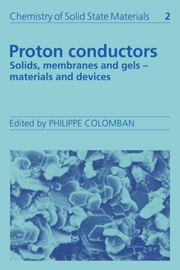Book contents
- Frontmatter
- Contents
- List of contributors
- Preface
- Symbols
- I HYDROGEN BOND AND PROTONIC SPECIES
- II MATERIALS: PREPARATION, STRUCTURES AND PROPERTIES
- III PROTON DYNAMICS AND CHARGE TRANSPORT
- 21 Incoherent neutron scattering studies of proton conductors: from the anhydrous solid state to aqueous solutions
- 22 NMR studies of local motions in fast protonic conductors
- 23 Vibrational spectroscopy of proton conductors
- 24 Raman spectroscopic studies of proton conductors
- 25 Frequency dependent conductivity, microwave dielectric relaxation and proton dynamics
- 26 Measuring the true proton conductivity
- 27 D.c. techniques and a.c./d.c. combination techniques
- 28 NMR in gels and porous media
- IV PROTON DIFFUSION MECHANISMS
- V DEVICES
- Index
25 - Frequency dependent conductivity, microwave dielectric relaxation and proton dynamics
Published online by Cambridge University Press: 04 May 2010
- Frontmatter
- Contents
- List of contributors
- Preface
- Symbols
- I HYDROGEN BOND AND PROTONIC SPECIES
- II MATERIALS: PREPARATION, STRUCTURES AND PROPERTIES
- III PROTON DYNAMICS AND CHARGE TRANSPORT
- 21 Incoherent neutron scattering studies of proton conductors: from the anhydrous solid state to aqueous solutions
- 22 NMR studies of local motions in fast protonic conductors
- 23 Vibrational spectroscopy of proton conductors
- 24 Raman spectroscopic studies of proton conductors
- 25 Frequency dependent conductivity, microwave dielectric relaxation and proton dynamics
- 26 Measuring the true proton conductivity
- 27 D.c. techniques and a.c./d.c. combination techniques
- 28 NMR in gels and porous media
- IV PROTON DIFFUSION MECHANISMS
- V DEVICES
- Index
Summary
Definitions
Electrical properties can be determined at various frequencies. The interaction between an electromagnetic wave and condensed matter can be described using permittivity and conductivity concepts. Fig. 25.1 shows the permittivity, a, versus frequency, v (or more usually ω= 2πν). In the high frequency region, there are various resonances arising from ionic (molecular) and electronic motions. The latter are usually described in terms of optical spectroscopy. In the low frequency region, on the other hand, dipolar and space charge relaxations, usually called dielectric relaxation, are expected. The space charge region, often observed in usual a.c. conductivity measurements, may be described in terms of a (complex) impedance formalism (see Chapters 26 & 27). These relaxations are directly related to the bulk conductivity and to electrode/electrolyte interfacial phenomena. They depend strongly on the microstructure on a 0.1–100 urn scale (porosity, surface topology) and on chemical reactions at the interface (polarization, diffusion). This low frequency domain corresponds to ‘free charges’, which can move in association with an alternative electric field, while the vibrational region at higher frequencies corresponds to ‘atom bonded fixed charges’ (‘dipoles’).
How are ions able to move in a solid? The standard answer to this question states that two different kinds of ionic motions can be discerned, namely oscillatory motion and jump diffusion (see Chapter 30). In fact, the motion is not only limited to oscillations and to statistical hopping from site to site.
- Type
- Chapter
- Information
- Proton ConductorsSolids, Membranes and Gels - Materials and Devices, pp. 389 - 408Publisher: Cambridge University PressPrint publication year: 1992
- 4
- Cited by



